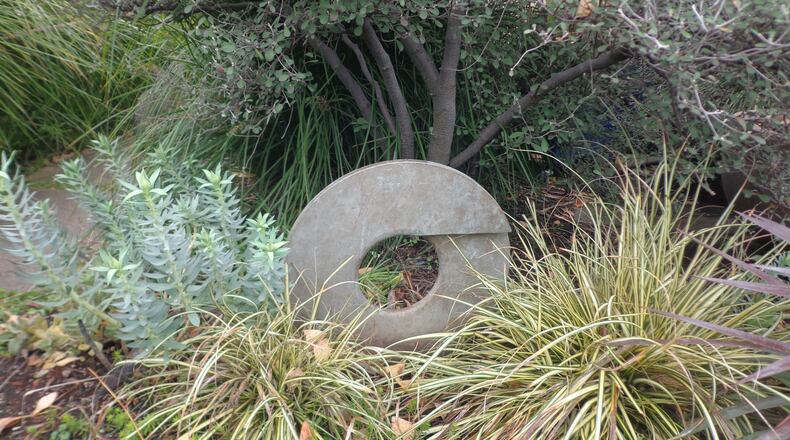The best example comes from Museo Frida Khalo in Coyoacan, Mexico. Frida and Diego collected pre-Columbian art, which still decorates this famous garden today. A thick carved doughnut excavated from an Aztec ball court, is an appreciation of culture and heritage. The dark stone stands out in high contrast amidst a mass of yellow variegated Liriopes bright enough to draw our attention with natural light.
Mill stones are another disk that is a remnant of past industry. Salvaged from antique mills, they are heavy but still available at reasonable prices. When standing on edge, their mass can be large enough to be anchored by exceptional planting. A collection of them are an opportunity to repeat this circular form throughout a larger garden. Stone wheels from farm sharpening stones are another more affordable option, widely available on the cheap in agricultural areas. They are stone and designed to be used, so these disks are tough and weather resistant.
Though not a stone disk, the sudden popularity of spoke wheels and large gears from early farm and industrial machinery are the salvage solution. Always perfectly round with a hole in the middle, they are essentially a thinner disk. These are usually rusty and decomposing so they’ll need a wilder looking setting for that “forgotten landscape” look of re-vegetation. In western states dryland plants and natives can be arranged the same way. Hunting for just the right disk makes junk shopping worthwhile.
This whole composition is subtle, so it doesn’t belong out in the middle of the yard. Let it sit within a natural setting where it blends into your existing landscaping. Use plants that work in your area to “nest” the object so it appears to have been there a long time. This is the “settled in” look that makes them visually belong in that space or planting milieu.
For some, making the disk stand up can be a challenge. It helps to bury the bottom a few inches deep and pack the soil around it for anchorage. Add staking or shims or any other method necessary to stabilize the disk from being blown or pushed over, then cover it all up with a lot of strap leaf plants.
Some great plants for achieving these looks without growing too large include:
Festuca glauca Blue Fescue Zone 4
Liriope ‘Silvery Sunproof’ Liriope Zone 6
Ophiopogon japonicus Mondo Grass Zone 10
Nassella tenuissima Mexican Feather Grass Zone 6
Every garden deserves a special place with a circular element linked in the ancient world to the heavens. Whether it’s the wheel off Grandad’s Model A or a priceless antique, it becomes the circle of life embodied in a single object. No matter the material or source; in garden design, it is simply the form that matters.
———
Maureen Gilmer is an author, horticulturist and landscape designer. Learn more at www.MoPlants.com
About the Author
